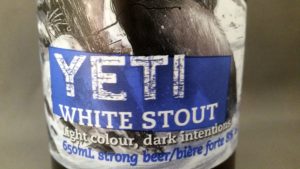I am going to start this post by admitting I don’t buy it. Regular readers will know that I am a bit old school when it comes to beer styles and how to identify what a beer is. If you are not sure what I mean read here and here.
Craft breweries love to experiment with bending styles, combining features of two styles or pushing a style outside its traditional parameters. To accommodate their myriad experimentation, they have started to blend style names or add adjectives to a traditional style to reflect what they are up to.
Sometimes I am totally cool with it. White IPA is a perfect example of trying to describe what you are doing. And I have come to terms with Cascadian Dark Ale (although I still refuse to call it Black IPA). But other times I get get grumpy at the twisting involved. Just because you have made a big version of something doesn’t mean you should call it “Imperial”.
Which brings me to the topic of today’s rantings – which actually is supposed to be a beer review. White Stout. This hybrid moniker has floated around for a few years, but hasn’t really taken off like some other hybrids have. From the beginning I have been skeptical. Being inky black is a defining feature of Stout, so how can you have a white one?
However, I will admit up until recently I have not actually tried one, so my complaints were purely linguistic and semantic. Then an old friend brought me a care package from B.C. It included some of her favourite offerings from the Fraser Valley. Specifically she brought a bottle of Old Yale’s Yeti White Stout. It is available in Alberta but I never got around to trying it.
As she is a good friend and I am one never to spurn new beer, I gave it a try.
It pours light gold and build a dense, pockmarked white head – very stout-like actually (except for the colour). The light gold immediately makes me ponder that at the very minimum they should be calling this hybrid Golden or Blonde Stout, as it is definitely not white.
The aroma gives off coffee, dark chocolate, touches of grainy malt and a soft fruit lingering in background. The coffee character gives me hope, but I remain unmoved as to the name.
The front of the sip is grainy malt, some toffee, light fruit and a hint of chocolate. In the middle I start to pick up bready notes and a bit of smokiness. Only after that does a sharp coffee roast kick in. The back end allows a light touch of earthy hops to emerge, but strictly in a back up role. The linger has a harsh coffee character reminding of getting a bit of grounds in your sip of coffee. It also has a slight alcohol vapour floating in the reminants (likely because the beer clocks in at 8% alcohol). The body is big rather than a stout-like full.
If I put my biases about the name aside, I find the beer to have an interesting mix of flavours. It comes across as a kind of smoky coffee ale. That said the roast, especially in the linger, is a bit too harsh and distracts from the beer’s finish. As well, I would have liked more chocolate in the flavour to balance the roast and to give it more of a stout-like character overall. A real stout would be fuller but more importantly smoother.
Sell this to me as a coffee blonde ale or some such and I am sold. It is not perfect but an interesting quaff. The problem is when you stick the word stout in the title you change my expectations. Suddenly I am looking for those qualities that define a stout – full body, light roast mixed with chocolate and dark fruits, and a smooth, malty and roasty finish.
This beer doesn’t have that. Maybe there are so-called white stouts that do. But at the moment I remain unconvinced that white stout is a thing.


Leave a Reply